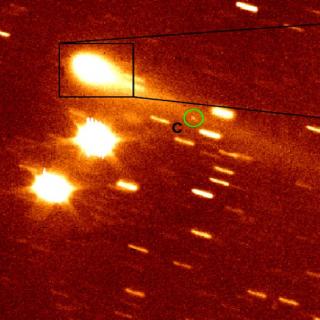Bibcode
Gherase, R. M.; Popescu, M.; Vaduvescu, O.; Wilson, T. G.; de León, J.; Lorenzi, V.; Licandro, J.; Morate, D.; Simion, G.; Macías, A. Aznar; Dumitru, B. A.
Bibliographical reference
Monthly Notices of the Royal Astronomical Society
Advertised on:
12
2024
Citations
0
Refereed citations
0
Description
The ground-based characterization of asteroids is a key step for planning their exploration. The near-Earth asteroid 155140 (2005 UD) is a potential flyby target of Japan Aerospace Exploration Agency's DESTINY+ (Demonstration and Experiment of Space Technology for INterplanetary voYage with Phaethon fLyby and dUst Science) mission, while (612267) 2001 SG286 has been considered as a possible target for in-situ exploration. We aim to determine their physical properties using the observations obtained with various telescopes from Canary Islands Observatory. For 2005 UD, we confirmed the two peak light curve, a rotation period of 5.224 $\pm$ 0.003 h and an amplitude of 0.34 mag. However, a three peak solution seemed also to fit the light curve, but this was discarded as implausible. Using the obtained visible to near-infrared spectrum we classified it as a Cb type, and we found a spectral matching with heated carbonaceous chondrite meteorites of CM2 type. The thermal emission flux at 2.2 $\mu \mathrm{ m}$ points to an albedo of $p_V = 0.06~\pm ~0.02$. There are significant differences in the spectrum of 2005 UD compared to that of (3200) Phaeton, hypothesized as its parent body. The accurate visible spectrum obtained with the Gran Telescopio Canarias indicate that 2001 SG286 is an S-type asteroid. The photometric data obtained with Isaac Newton Telescope suggest a rotation period of 12.30 $\pm$ 0.01 h and an amplitude of 0.64 mag. With these observations we found its absolute magnitude $H$ = 21.4 $\pm$ 0.3, and estimate its size as 160 $\pm$ 45 m.
Related projects

Small Bodies of the Solar System
This project studies the physical and compositional properties of the so-called minor bodies of the Solar System, that includes asteroids, icy objects, and comets. Of special interest are the trans-neptunian objects (TNOs), including those considered the most distant objects detected so far (Extreme-TNOs or ETNOs); the comets and the comet-asteroid
Julia de
León Cruz